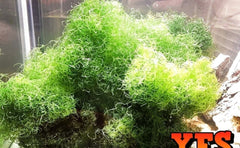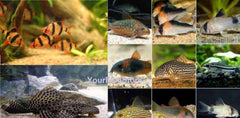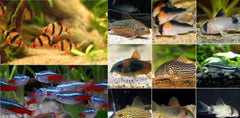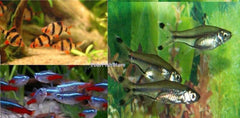X15 Assorted Rasbora - 1/2" - 1" Each - Freshwater Fish
Ebay
$ 118.53

x15 ASSORTED RASBORA - 1/2" - 1" EACH - FRESHWATER FISH - FREE SHIPPING
They will be scooped out our holding tanks. We cannot guarantee we will be able to scoop ALL different types, but we will try to get a good variety.
The Assorted Picks will be from the list below:
Black Rasbora Het Florida
Brilliant Rasbora
Clown Rasbora
Dwarf Emerald Rasbora
Emerald Eye Rasbora
Green Axelrodi Rasbora
Rasbora Het Florida
Scissortail Rasbora
To encourage spawning, pair a young (9-12 months old) female Harlequin Rasbora with a two-year old male and offer live food items. After spawning, remove the parents and keep the aquarium dark until the eggs hatch (after about 24 hours). Feed the fry infusoria.
The Harlequin Rasbora Trigonostigma heteromorpha (previously Rasbora heteromorpha) is immensely popular. These extremely desirable fish are always on the move. A lively school at the top of the aquarium has an endearing, fiery persona that just radiates attitude. This cyprinid has been a favorite aquarium fish for about 100 years. It was first described by Duncker back in 1904 and hails from Southeast Asia. It is found on the Malay Peninsula, throughout western Malaysia and southern Thailand as well as Singapore.
These small, elegant fish look their best when kept In ideal conditions. They won't quite reach 2 inches (5 cm) in length, and they can be variable in color, ranging from a pale pink or bright red to a copper orange along the top and bottom. The back halves of these little fish have a black triangular or hatchet-shaped patch with a bluish tint. They will sometimes have subtle purple highlights in front of the patch as well.
With these decorative colors, they are aptly dubbed Harlequin Rasbora, or sometimes just Harlequin or Harlequin Fish. Most individuals have a rosy hue, so another common name for them is Red Rasbora. However, varieties that are more copper or golden are sometimes called Gold Harlequin Rasbora. Varieties with a black patch and a mostly black body are called Black Harlequin Rasbora, and those with a strong bluish tinting will sometimes be referred to as Blue Harlequin Rasbora.
This fish is often confused with two of its close relatives, the Glowlight Rasbora Trigonostigma hengeli and the Lambchop Rasbora Trigonostigma espei. To accurately identify them, pay attention to some subtle distinctions. The Harlequin Rasbora is pale pink to bright red and much stockier than its cousins. Harlequin’s black mark is more triangular and will have a noticeably blue tint. The Espei Rasbora should be bronze pink in color and more elongated. Hengel’s Rasbora should be yellow cream with a thin black side marking topped with a sweep of neon orange.
These agreeable fish do fine in most community settings and even better with other cyprinids. They aren’t aggressive per se but can be a bit boisterous. The companionship of their own species is absolutely essential, so a school is a must. You really haven’t seen the Harlequin Rasbora until you’ve seen a school of 10 or more individuals in an established tank. Because these are excellent schooling fish, they need a fairly large aquarium. A 20-gallon tank would be the bare minimum, but they are best suited to a 30-gallon aquarium that is at least 36 inches long to allow them to swim freely.
They are very tolerant fish but do require a little extra care, so they are suggested for aquarists with a bit of experience. They can adapt to a variety of conditions but need soft, slightly acidic water. They won't do well when kept in hard water. To bring out their best colors, use a dark substrate and provide them with plenty of plants. A well-planted aquarium will really showcase their colors to best effect. Keep the tank carefully covered as these fish are liable to jump if startled or excited.
QUESTIONS & ANSWERS
Have a Question?
Be the first to ask a question about this.














